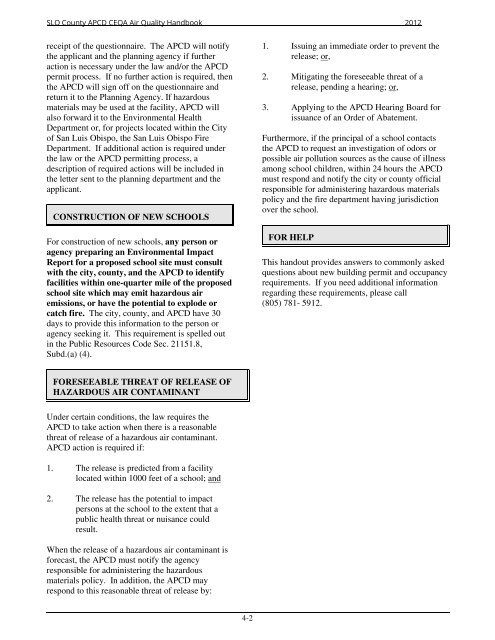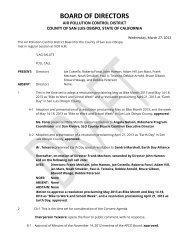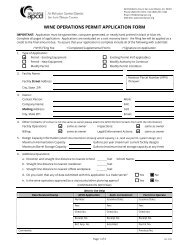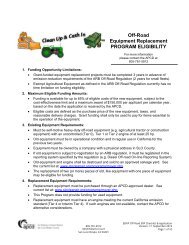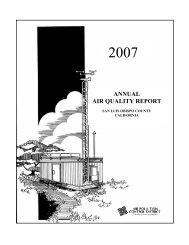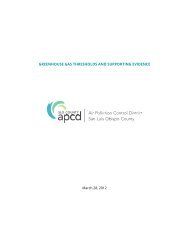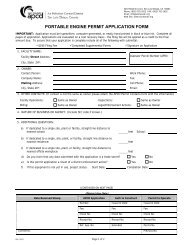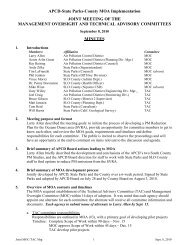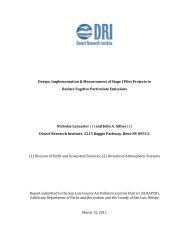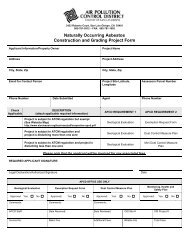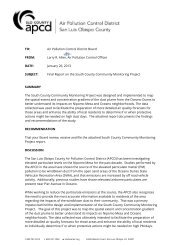CEQA Air Quality Handbook - Air Pollution Control District
CEQA Air Quality Handbook - Air Pollution Control District
CEQA Air Quality Handbook - Air Pollution Control District
Create successful ePaper yourself
Turn your PDF publications into a flip-book with our unique Google optimized e-Paper software.
SLO County APCD <strong>CEQA</strong> <strong>Air</strong> <strong>Quality</strong> <strong>Handbook</strong> 2012<br />
receipt of the questionnaire. The APCD will notify<br />
the applicant and the planning agency if further<br />
action is necessary under the law and/or the APCD<br />
permit process. If no further action is required, then<br />
the APCD will sign off on the questionnaire and<br />
return it to the Planning Agency. If hazardous<br />
materials may be used at the facility, APCD will<br />
also forward it to the Environmental Health<br />
Department or, for projects located within the City<br />
of San Luis Obispo, the San Luis Obispo Fire<br />
Department. If additional action is required under<br />
the law or the APCD permitting process, a<br />
description of required actions will be included in<br />
the letter sent to the planning department and the<br />
applicant.<br />
CONSTRUCTION OF NEW SCHOOLS<br />
For construction of new schools, any person or<br />
agency preparing an Environmental Impact<br />
Report for a proposed school site must consult<br />
with the city, county, and the APCD to identify<br />
facilities within one-quarter mile of the proposed<br />
school site which may emit hazardous air<br />
emissions, or have the potential to explode or<br />
catch fire. The city, county, and APCD have 30<br />
days to provide this information to the person or<br />
agency seeking it. This requirement is spelled out<br />
in the Public Resources Code Sec. 21151.8,<br />
Subd.(a) (4).<br />
1. Issuing an immediate order to prevent the<br />
release; or,<br />
2. Mitigating the foreseeable threat of a<br />
release, pending a hearing; or,<br />
3. Applying to the APCD Hearing Board for<br />
issuance of an Order of Abatement.<br />
Furthermore, if the principal of a school contacts<br />
the APCD to request an investigation of odors or<br />
possible air pollution sources as the cause of illness<br />
among school children, within 24 hours the APCD<br />
must respond and notify the city or county official<br />
responsible for administering hazardous materials<br />
policy and the fire department having jurisdiction<br />
over the school.<br />
FOR HELP<br />
This handout provides answers to commonly asked<br />
questions about new building permit and occupancy<br />
requirements. If you need additional information<br />
regarding these requirements, please call<br />
(805) 781- 5912.<br />
FORESEEABLE THREAT OF RELEASE OF<br />
HAZARDOUS AIR CONTAMINANT<br />
Under certain conditions, the law requires the<br />
APCD to take action when there is a reasonable<br />
threat of release of a hazardous air contaminant.<br />
APCD action is required if:<br />
1. The release is predicted from a facility<br />
located within 1000 feet of a school; and<br />
2. The release has the potential to impact<br />
persons at the school to the extent that a<br />
public health threat or nuisance could<br />
result.<br />
When the release of a hazardous air contaminant is<br />
forecast, the APCD must notify the agency<br />
responsible for administering the hazardous<br />
materials policy. In addition, the APCD may<br />
respond to this reasonable threat of release by:<br />
4-2


